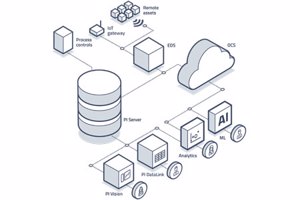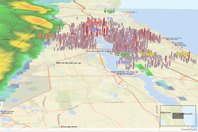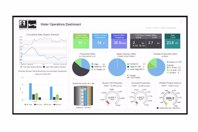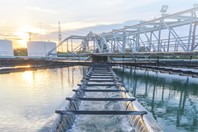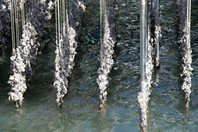
ABOUT AVEVA
Founded in 1980, AVEVA has consistently focused on a single goal: to get operational data into the hands of people in industrial environments so that they have the information they need to reduce costs, increase productivity and transform business.
The value of AVEVA and the PI System can be summarized as follows: helping any critical industrial enterprise to make better decisions, execute highly efficient operational and business processes, and differentiate their product and service offerings.
- Enables new growth by delivering real-time, high fidelity data that leads to insights that can impact revenue, margin, and enable new business and product development opportunities
- Reduce operating costs associated with unplanned downtime of expensive/critical assets; process, asset, and energy inefficiencies; and, regulatory compliance
- Maintain safety and reduce risk by enabling situational awareness across machines, systems, and plants
AVEVA at a Glance:
- Founded in 1980
- Implemented in 21,000 sites
- Service customers in 140 countries
- 65% of industrial Fortune 500 customers
- 24/25 first customers are still using AVEVA
- 1,400+ employees in offices throughout the world
- Worldwide, AVEVA delivers over 2b data streams (/day)
- AVEVA is headquartered in San Leandro California
CONTACT INFORMATION
AVEVA
San Leandro Tech Campus, 1600 Alvarado Street
San Leandro, CA 94577
UNITED STATES
AVEVA FEATURED CONTENT
-
The City of Riverside PUD discusses how they are quantifying ROI and also the ever-evolving digital transformation taking place in the water industry,
-
In a broader landscape being transformed by data, water utilities face their own unique challenges in adopting digital transformation strategies.
-
OSIsoft brings you some perspective on how the U.S. water utility sector has evolved – and continues to evolve – in its use and management of data.
-
A resilient mindset is critical for decision-making in times of increased uncertainty in the utilities sector. Both the natural climate and the political climate are more prone than ever to instability. Your organization can’t completely control these factors, but resilience allows you to adapt quickly and prepare for future disruptions to the status quo.
-
The problem: there is no unified way of accessing water and wastewater data for analysis and as a result only a fraction of data collected by utilities is analyzed and turned into actionable information. The solution? Read on to find out.
-
The White House Utility District (WHUD) is the largest water utility in Tennessee by geography, serving consumers and businesses just north of Nashville. Since it started making better use of its sensor-based data using state-of-the-art IIoT (Industrial Internet of Things) technologies in 2016, its infrastructure leakage index (ILI) decreased from 1.49 to 0.76. In this episode we talk about pressure management, leaks, and I&I with those who made the changes to improve their operation.
-
The city of Salem had a water scare in the summer of 2018. A harmful algal bloom had threatened the quality of their drinking water. They partnered with Casne Engineering and The Prediction Lab (TPL) to ramp up their data efforts to create advanced algorithms. Now, using OCS (OSIsoft Cloud Services) they bring together a variety of data sources such as satellite images and lake measurements to predict water quality and proactively mitigate any potential issues.
-
Riverside, CA, had a wealth of data, but in 30 separate systems, and reporting was time-intensive. Their solution was to integrate all real-time and operational data into the PI System, and create dashboards and automated reports for deeper and faster data access. Read the full case study to learn more.
-
Utilities that had invested in remote monitoring and cloud-based operational systems before COVID-19 stay-at-home orders were issued were able to shift gears to remote operations. Those that had not were left to struggle with skeleton crews, delayed billings, or other disruptions. Here are some perspectives on how all utilities can operate as the essential services they are, regardless of the challenges they encounter.
-
For as many water/wastewater utilities that use SCADA systems inside their treatment facilities, there are many where that automated data collection and control all but ends at the property line. In reality, a significant percentage of customer service and performance efficiency opportunities exist ‘beyond the fence.’ Here is how utilities can use remote monitoring to leverage those opportunities for success.
-
Being more proactive in sharing utility operational insights with customers can pay dividends in terms of promoting efficiency and elevating customer satisfaction. It can also prepare utilities to respond more effectively to sudden or drastic disruptions of standard operations, such as droughts, floods, wildfires, or health emergencies. Here is how to establish and benefit from greater transparency.
-
As essential services, water and wastewater utilities face a lot of pressure to maintain continuity despite a variety of challenges — stormy weather, natural disasters, and even global pandemics. In-plant instrumentation, SCADA systems, and remote sensors all have their roles. But for more holistic views and higher-level analyses of performance patterns, an operational intelligence system can help to maximize resiliency.
-
Water and wastewater utilities are vital to our ability to have clean drinking water and mitigate waterborne diseases. However, operating efficiently while providing safe, quality services and staying compliant is no small feat. Add in a disaster, such as a fire, a drought, or an unforeseen global pandemic like COVID-19, and utilities must adapt to ever-changing conditions while maintaining the trust of the customers they serve. Maintaining that trust and customer goodwill is critical during times of crisis, and the only way to do so is through transparency
-
Real-time data is the first line of defense for wastewater utilities. A data infrastructure serves as a window into critical operations, allowing employees to optimize equipment performance and hedge against risk. It is often the most economical solution as well: in many cases, utilities already have many of the core elements for an actionable data infrastructure for improving decision making.
-
The internet of things (IoT) is transforming the water utilities industry. From sensors that collect flow and pressure information in remote locations to smart meters that upload data continuously into the cloud, more and more equipment is generating endless streams of data.
-
This video focuses on leading water and wastewater utilities who have embraced and leveraged digital technologies such as smart sensors/devices, IoT, better connectivity, and software. You'll discover that by creating a data strategy and using real-time data your water utility will drive smarter decisions to reduce opex and capex, increase asset life, meet environmental compliance, etc. while reducing risk.
-
This video focuses on leading water and wastewater utilities use cases that have embraced and leveraged digital technologies such as smart sensors/devices, IoT, better connectivity, and software. You'll see examples from utilities that have created a data strategy and are using real-time data that is driving smarter decisions to reduce opex and capex, increase asset life, meet environmental compliance, etc. while reducing risk.
-
Water industry professionals are experiencing a data deluge. There’s a lot of data out there, gathered from sensors monitoring everything from water quality to pipe bursts — but altogether, it’s too much data divided among too many silos to make sense of what it all means.
-
Learn how you can maximize ROI through digital transformation.
-
Technology developments like the Industrial Internet of Things (IIoT) and big data analytics can provide the tools to tackle the issues faced by the water and wastewater sector.
-
With increased pressure for smarter infrastructure, the ability to quickly change direction and integrate processes across stakeholders has emerged as a trend "needed at every level of the infrastructure ecosystem."
-
Discover why business, healthcare, and higher education facilities are using AVEVA PI System and AVEVA trusted partners to cut energy costs and consumption, improve resiliency, maximize maintenance strategies, diagnose asset performance, and make progress toward net-zero emissions goals.
-
This paper discusses how the right combination of digital tools is helping cities move from a reactive response to delivering a more sustainable future while saving costs and connecting the workforce to trusted data.
-
Discover how AVEVA helped operate and maintain nearly 765 miles of sewer lines, and deliver more than 40 million gallons of wastewater per day to Los Angeles County sanitation district facilities.
-
Learn how water and wastewater utilities can use data to find operational efficiencies can both reduce energy costs and reduce carbon emissions.
-
Despite improved production equipment, being able to reduce energy costs and conserve precious water resources still relies on collecting, managing, analyzing, understanding, and leveraging data efficiently. Here’s how to do it.
-
While the ‘digital twin’ concept has been around for decades, most of the talk about it in water and wastewater treatment has focused on using it to monitor and manage active operations. Here is an advance look at the value they offer.
-
To meet ever-more-demanding safety regulations and to keep pace with the rapid proliferation of new dairy products, all while optimizing operations across the entire enterprise, dairy processors are increasingly turning to digital twins. This article explores this new automated solution that enables manufacturers to model production processes and asset performance in a safe, virtual environment.
-
Optimizing water and wastewater operations requires analyzing a lot of variables and the relationships among them. One good way to do that is with a digital twin — a digital parallel to a physical system — that can be used to test and develop new analytics or control strategies without disrupting real-time operations. Here are several examples of how to use digital twins to yield more efficient results.
-
Dealing with the glut of data generated by water treatment plants (WTPs), distribution systems, sewer and stormwater collection systems, and wastewater treatment plants (WWTPs) can be like trying to take a sip from a fire hose. Here is how an optimized approach to ‘smart water’ data analytics can make the difference between struggling with implementation and flourishing with efficiency.
-
The concept of ‘drowning in data but starving for information’ might be a slight exaggeration in smaller, well-established water or wastewater treatment operations, but collecting more data than is typically used certainly strikes a familiar chord. With all the buzz about ‘smart water,’ there must be a way to make better use of available data without breaking the bank. Here are some principles to consider.
-
For water treatment plants (WTPs) and wastewater treatment plants (WWTPs) pressured to do more with their data despite being pinched by a tight budget and a need to retrain employees, a new strategy can make all the difference. Here is how one such approach makes ‘smart water’ analytics less intimidating and how it has helped one utility make more cost-effective decisions while saving precious time and money.
-
The food and beverage industry faces massive headwinds from shifting market dynamics. As consumer appetites for high-end options — such as organic foods and eco-friendly packaging — continue to grow, innovation in products, materials, and technologies allows these items to rapidly make their way from developmental concept to store shelves. While shoppers are engaging at record levels, and the potential to profit is greater than ever, manufacturers must rise to a new level of optimization to remain competitive.
-
The chemistry of optimizing water/wastewater treatment extends far beyond chlorine and oxygen. It also involves synthesizing productive insights from the flood of IT data generated by operational technology (OT) sensors, instruments, and control systems. Here’s how better operational intelligence strategies are helping IT and OT personnel collaborate to make processes more cost-efficient.
-
With electricity consumption being a primary operating cost in water treatment and wastewater treatment, steps taken to optimize energy use are critical. Saving energy is more than just an on/off decision. Monitoring and managing energy use — from analyzing pump curves, to reducing non-revenue-water leaks, to scheduling operations around premium-rate windows — is essential. Fortunately, the payback potential can be impressive.
-
Although an ounce of prevention is worth a pound of cure, all the money spent on regularly scheduled maintenance can add up to a ton of waste — and still result in unplanned downtime — if asset managers can’t reasonably differentiate between which equipment truly needs attention and which doesn’t. Fortunately, data-centric analytics derived from physical performance in real time can make that distinction. Here’s how.
-
The storm was a one-in-ten-year event. But it’s one that the engineers at TasWater, the water and wastewater agency for Tasmania, realized the people in the region would remember for a long, long time.
-
In water and wastewater operations, optimizing energy use plays a huge role in cost efficiency, but how can you know if pumping equipment and other motors are running as efficiently as possible? Analytics systems that interpret performance from a variety of data points — pump curves, run time, flow rates, vibration, temperature, energy consumption, etc. — can quantify pump operation to keep performance efficiency on an upward track.
-
In this video, you'll see examples from utilities that have created a data strategy and are using real-time data that is driving smarter decisions to reduce opex and capex, increase asset life, meet environmental compliance, etc. while reducing risk.
-
Combined and sanitary sewer overflows are natural hazards for wastewater collection systems. Without a comprehensive solution to monitor troublesome conditions, overflows can be triggered with little warning and lead to expensive and embarrassing situations. Fortunately, versatile analytical systems that capitalize on existing wastewater collection infrastructure hold promise for avoiding such negative impacts.
-
In 2007, White House Utility District (WHUD), a water utility serving approximately 90,000 consumers and businesses in Tennessee, faced a dilemma: how to meet a projected growing demand for water within the budget and capital constraints faced by municipal and mid-sized utilities everywhere.
-
Thames Water focuses on extracting value from specific combinations of structured and unstructured business data together with real-time operational data provided by Thames' PI System from across more than 3000 plant and 140,000 km of water and sewerage networks.
-
Dr. Francisco Castillo speaks on their FIELD MOUS system (Field MOnitoring User System), where a PI System acts as a repository of technical data into which different departments plug their data, and other departments access it to fit their particular needs.
-
With the proliferation of sensors, data collection, and cloud storage, there is the potential for operational insight heretofore never available, and the opportunity will only expand as the technology evolves and the Internet of Things becomes, well, more of a thing. But data is only truly useful if it informs decision-making that results in positive impact — for an organization's bottom line, its personnel, its customers, or even the world at large (i.e., the environment).
-
Colorado Springs Utilities internal customers can see lab results more quickly and as a result are reducing costs by optimizing their facilities by 30%.
-
Ian Scott describes the key landmarks in its use of the PI System and the evolution towards using the PI System as the cornerstone infrastructure of its business.
-
The water burbling down the rural hillside, nurturing the thick foliage, certainly looked like a stream.
-
At 10am on August 24, 2017, a customer in Midway Point, a small suburb outside of Hobart, Tasmania, reported a sewage spill on his property. Midway Point stands adjacent to Pitt Water Nature Reserve, home to rare birds, butterflies, and the largest oyster lease in Tasmania, covering some 14 hectacres. In late August, Pitt Water oysters, prized for their briny flavor and consistency, were just coming into peak condition.

